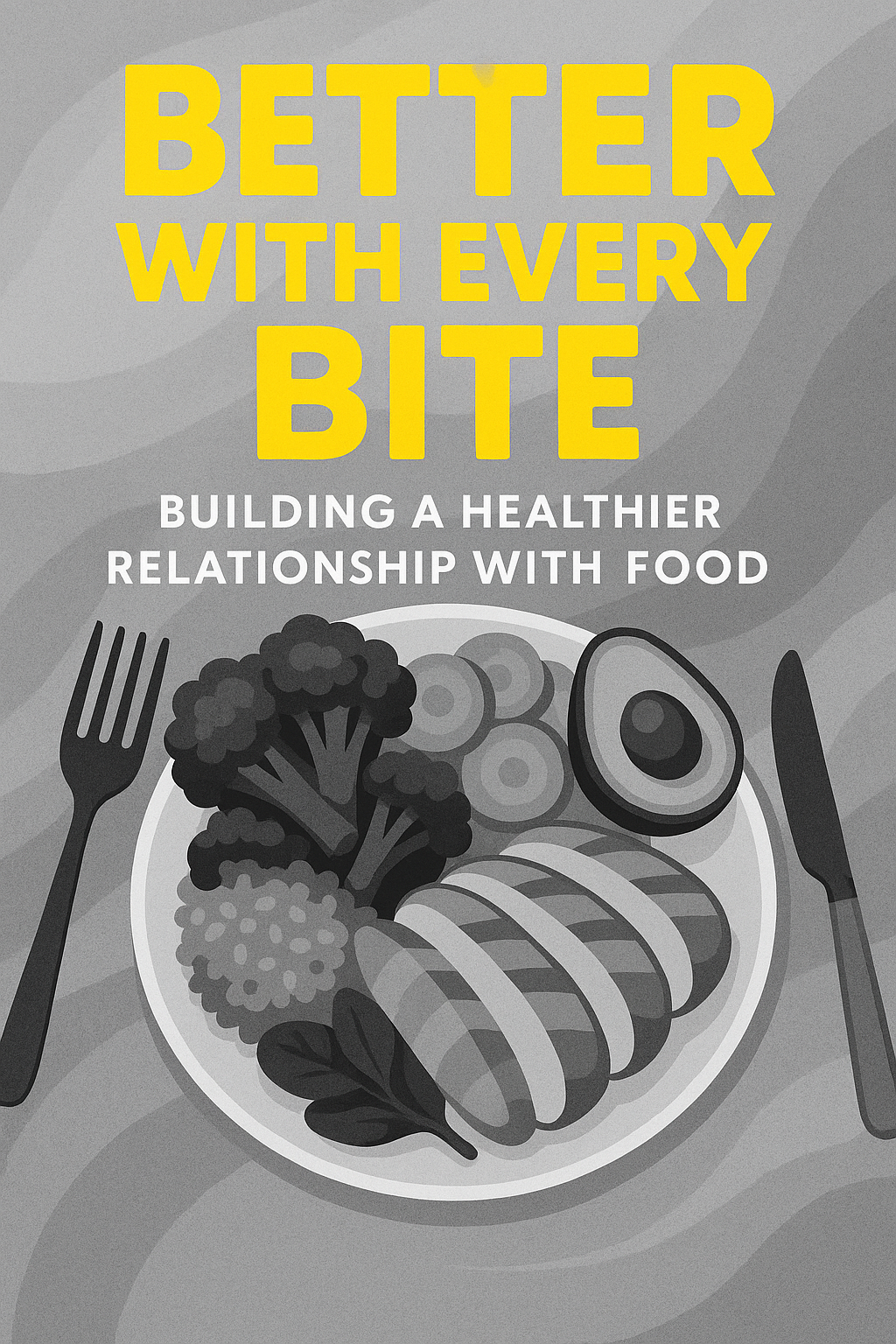
Better With Every Bite

Better With Every Bite: Building a Healthier Relationship with Food
By George Colletti
⸻
Table of Contents
1. Introduction
2. Why Our Relationship with Food Gets Complicated
3. Emotional Eating: When Feelings Dictate Food
4. Diet Culture: Unlearning What We’ve Been Taught
5. Restriction and Binge Cycles
6. The Role of Habits and Environment
7. Nutritional Confusion: Too Much Advice, Not Enough Clarity
8. Fixing the Relationship: Principles for Eating Well
9. Mindful Eating and Intuitive Practices
10. Healing Through Education, Not Guilt
11. Building a Lifestyle, Not a Diet
12. Final Words: You Deserve Peace with Food
⸻
Chapter 1: Introduction
Food is more than fuel. It’s comfort, celebration, culture, and connection. But for many, it’s also stress, guilt, and confusion. If you’ve ever felt stuck in a cycle of bad habits, food shame, or yo-yo dieting, you’re not alone—and you’re not broken.
This book will guide you through the reasons why many people struggle with nutrition and offer practical ways to build a more peaceful, empowering relationship with food.
⸻
Chapter 2: Why Our Relationship with Food Gets Complicated
From a young age, we’re taught mixed messages about food. Some are rooted in culture, others in marketing, and many in fear. Common reasons people struggle include:
• Emotional eating
• Cultural or family habits
• Chronic dieting or restriction
• Food insecurity or trauma
• Confusion from contradicting nutritional advice
• Body image issues
• Lack of education around nutrition
• All-or-nothing mindset
Understanding these root causes is the first step toward healing.
⸻
Chapter 3: Emotional Eating: When Feelings Dictate Food
Emotional eating happens when we use food to numb or avoid feelings—boredom, stress, sadness, even joy. While it’s normal to find comfort in food occasionally, emotional eating becomes a problem when it’s the primary coping mechanism.
Fix:
• Pause before eating—ask “What do I really need?”
• Journal your emotions regularly
• Build a toolkit of non-food coping skills (walks, talking to a friend, creative outlets)
• Practice self-compassion; you’re not weak, you’re human
⸻
Chapter 4: Diet Culture: Unlearning What We’ve Been Taught
Diet culture teaches us that our worth is tied to our weight, and that thinness equals health. It pushes restriction, quick fixes, and unsustainable habits.
Fix:
• Unfollow social media that glorifies diet culture
• Learn to separate “health” from “thinness”
• Focus on how food makes you feel, not just how it makes you look
• Question food rules like “no carbs” or “cheat days”
⸻
Chapter 5: Restriction and Binge Cycles
When we deprive ourselves, we set ourselves up for bingeing. The cycle looks like this: restrict → crave → binge → guilt → restrict again.
Fix:
• Eat regularly and don’t skip meals
• Give yourself unconditional permission to eat all foods
• Focus on fullness and satisfaction, not just calories
• Learn to trust your body again
⸻
Chapter 6: The Role of Habits and Environment
What we eat often reflects our environment—busy schedules, food availability, and even who we eat with. Habits formed over years can be hard to break.
Fix:
• Keep nutritious foods visible and accessible
• Plan meals and snacks ahead of time
• Create routines that support healthy choices (like Sunday meal prep)
• Make your kitchen a place that supports your goals
⸻
Chapter 7: Nutritional Confusion: Too Much Advice, Not Enough Clarity
From keto to intermittent fasting to plant-based diets, the internet is flooded with conflicting information. This overload can paralyze us or send us chasing every new trend.
Fix:
• Focus on basic principles: whole foods, balance, variety
• Learn how your body reacts to different foods
• Use trusted, evidence-based sources or a registered dietitian
• Remember: perfect nutrition doesn’t exist
⸻
Chapter 8: Fixing the Relationship: Principles for Eating Well
A healthy relationship with food is built on trust, consistency, and respect for your body.
Core Principles:
• Eat enough: Undereating leads to cravings and fatigue
• Balance: Include protein, carbs, fat, and fiber in meals
• Satisfaction matters: Don’t eat what you hate just because it’s “healthy”
• Listen to hunger and fullness cues
• Hydrate: Many cravings are actually dehydration
⸻
Chapter 9: Mindful Eating and Intuitive Practices
Mindful eating means being present with your food—slowing down, savoring each bite, and noticing how food feels in your body.
Practices to Try:
• Eat without screens
• Chew slowly
• Ask how hungry/full you are before and after meals
• Reflect after eating: did that satisfy me?
⸻
Chapter 10: Healing Through Education, Not Guilt
Guilt is not a useful nutrition tool. Education, however, is. When you understand what your body needs and how food works, you’re empowered—not controlled.
Shift From:
• “I blew it, I might as well keep eating junk”
To:
• “That wasn’t the best choice, but I can make a better one next time.”
⸻
Chapter 11: Building a Lifestyle, Not a Diet
The goal isn’t to be perfect. It’s to be consistent enough that healthy choices become your default, not your obsession.
How to Make It Stick:
• Choose sustainable habits (cook 3 nights/week instead of 7)
• Don’t outlaw foods—include them in moderation
• Track progress by how you feel, not just how you look
• Celebrate small wins: energy, better sleep, improved mood
⸻
Chapter 12: Final Words: You Deserve Peace with Food
Your relationship with food doesn’t have to be a lifelong battle. With patience, compassion, and clarity, you can move from guilt and confusion to confidence and peace.
Food is meant to nourish you, not punish you. You don’t need another diet—you need a foundation of trust, built one bite at a time.